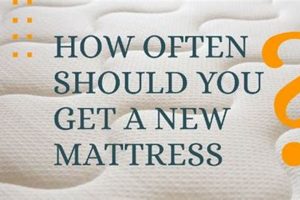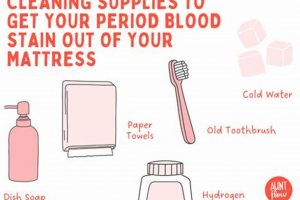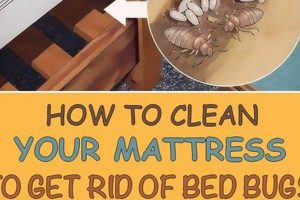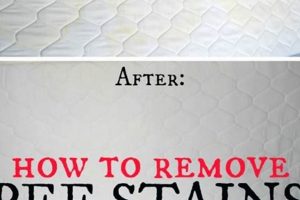Effective urine stain and odor removal from a mattress involves a multi-step process. The initial step typically includes absorbing any remaining liquid using absorbent materials. This is followed by applying a cleaning solution, often a mixture of enzymatic cleaners, baking soda, or vinegar and water, to neutralize the uric acid crystals responsible for the persistent odor. The solution is left to sit for a period before being blotted and allowed to air dry completely.
Maintaining a clean and sanitary sleeping environment is paramount for health and hygiene. Residual urine can foster bacterial growth and attract pests, potentially leading to allergic reactions or other health concerns. Historically, various methods, from sun-drying mattresses to using harsh chemical cleaners, have been employed to address this issue, highlighting the long-standing need for effective and safe cleaning techniques.
The subsequent sections will delve into specific cleaning agents, step-by-step procedures, and preventative measures to ensure thorough and long-lasting results when addressing urine contamination in mattresses.
Guidance for Mattress Urine Stain Remediation
The following guidance outlines key strategies to mitigate urine contamination within mattresses, focusing on effective stain and odor elimination.
Tip 1: Immediate Action is Crucial: Promptly address urine incidents. Delayed intervention allows deeper penetration into the mattress fibers, complicating removal efforts and intensifying odor.
Tip 2: Absorbent Material Utilization: Employ clean cloths, paper towels, or specialized absorbent pads to blot the affected area. Avoid rubbing, as this spreads the stain and drives the urine further into the material.
Tip 3: Enzymatic Cleaner Application: Utilize an enzymatic cleaner specifically designed for urine removal. These cleaners break down the uric acid crystals responsible for the persistent odor. Follow the manufacturer’s instructions carefully.
Tip 4: Baking Soda Deodorization: Generously apply baking soda to the treated area after cleaning. Baking soda absorbs residual moisture and odors. Allow it to sit for several hours, preferably overnight, before vacuuming thoroughly.
Tip 5: Vinegar and Water Solution: For less severe cases, a solution of equal parts white vinegar and water can be effective. Apply the solution lightly, blot, and allow to dry completely. Vinegar’s acidity helps neutralize urine odors.
Tip 6: Thorough Drying is Essential: Ensure the mattress is completely dry after treatment. Use fans or a dehumidifier to expedite the drying process. Moisture retention can lead to mold and mildew growth.
Tip 7: Mattress Protector Implementation: Invest in a waterproof mattress protector. This preventative measure safeguards against future urine accidents and other spills, preserving the mattress’s integrity.
These strategies emphasize the importance of immediate, thorough, and preventative actions in maintaining a hygienic sleep environment and extending the lifespan of the mattress.
The subsequent article sections will address advanced stain removal techniques and long-term mattress care strategies.
1. Absorption
Absorption plays a fundamental role in mitigating urine contamination within a mattress. Its prompt application significantly influences the overall efficacy of subsequent cleaning procedures, thus impacting the “best way to get urine out of mattress.”
- Immediate Fluid Removal
The initial step in addressing urine contamination involves the immediate absorption of liquid. The goal is to minimize the penetration of urine into the deeper layers of the mattress. Absorbent materials, such as clean cloths or paper towels, are applied to wick away the fluid before it can saturate the mattress fibers. Failure to promptly remove excess liquid makes subsequent cleaning stages more challenging and less effective.
- Material Selection for Optimal Absorption
The type of absorbent material used affects the efficiency of fluid removal. Highly absorbent materials, such as microfiber cloths or specialized absorbent pads, are preferable. These materials can hold a greater volume of liquid compared to less absorbent options, reducing the need for frequent replacements and improving the speed of the initial cleanup process. Using inappropriate materials, such as terrycloth towels, may not be as effective at drawing out the urine.
- Blotting Technique
The application technique significantly influences the effectiveness of absorption. Blotting, rather than rubbing, is essential. Rubbing spreads the urine over a larger area and forces it deeper into the mattress fibers, making complete removal more difficult. Blotting applies direct pressure to lift the liquid out of the mattress, concentrating the cleanup efforts and preventing further saturation.
- Post-Cleaning Moisture Control
Absorption also extends to the post-cleaning phase. After applying cleaning solutions, blotting is used to remove excess moisture and cleaning residue. This step is crucial to prevent the growth of mold and mildew within the mattress, which can occur if moisture is trapped within the fibers. Thorough absorption during this phase contributes to a cleaner and more hygienic outcome.
In summary, absorption is a crucial initial and intermediary step that sets the foundation for successful urine removal from a mattress. Its proper execution directly influences the effectiveness of subsequent cleaning methods, contributing to the goal of fully remediating urine contamination.
2. Enzymatic Cleaners
Enzymatic cleaners represent a key component in effectively removing urine from mattresses. These specialized cleaning agents contain enzymes that catalyze the breakdown of organic compounds present in urine, specifically uric acid crystals. These crystals are the primary source of the persistent odor associated with urine contamination. Traditional cleaning methods often mask the odor or address surface stains but fail to eliminate the underlying cause. The enzymatic action targets these uric acid crystals, degrading them into smaller, odorless components that are then more easily removed. Without this targeted action, residual uric acid can continue to emit odors, rendering the cleaning process incomplete.
A common example illustrating the efficacy of enzymatic cleaners involves households with pets. Pets may urinate on mattresses, leaving behind not only stains but also strong, lingering odors. In such scenarios, simply using soap and water might remove the visible stain, but the odor frequently persists. However, an enzymatic cleaner breaks down the uric acid, eliminating the odor at its source and discouraging repeat offenses by the animal. This effectiveness has led to widespread adoption of enzymatic cleaners in professional cleaning services specializing in pet stain and odor removal. Their significance lies in providing a solution that addresses the root cause of the problem, rather than merely masking it.
In summary, enzymatic cleaners constitute a crucial element in the effective remediation of urine contamination in mattresses. Their targeted action on uric acid crystals distinguishes them from conventional cleaning approaches and contributes to long-term odor elimination. The ability to break down the source of the odor makes them an important step. Their inclusion significantly increases the probability of successfully achieving thorough and lasting urine removal from mattresses, ultimately contributing to a healthier and more hygienic sleep environment.
3. Baking Soda
Baking soda (sodium bicarbonate) is a widely recognized component in strategies for urine stain and odor remediation on mattresses. Its absorbent and deodorizing properties make it a valuable tool when pursuing effective mattress cleaning methods.
- Odor Neutralization
Baking soda possesses the ability to neutralize acidic and alkaline odors, including those produced by urine. It reacts chemically with odor molecules, transforming them into less volatile and less odorous compounds. This makes it more effective than simply masking smells. In households, baking soda is often placed in refrigerators or closets to absorb unwanted odors, demonstrating its practical application in odor control.
- Moisture Absorption
Baking soda is a desiccant, meaning it can absorb moisture from its surroundings. When applied to a urine-contaminated mattress, it draws out residual moisture, reducing the likelihood of mold and mildew growth. This is particularly important as moisture can exacerbate odors and contribute to unsanitary conditions. For example, baking soda is commonly used to absorb moisture in damp shoes or gym bags.
- Buffering Agent
Baking soda acts as a buffering agent, helping to maintain a stable pH level. Urine can alter the pH of mattress fibers, potentially damaging them or promoting bacterial growth. By neutralizing these pH imbalances, baking soda helps to protect the integrity of the mattress material and inhibit microbial activity.
- Application Methodology
The effectiveness of baking soda hinges on proper application. A generous layer of baking soda should be applied to the affected area, ensuring complete coverage. The baking soda needs to sit for several hours, or preferably overnight, to allow sufficient time for odor absorption and moisture extraction. Following this, it is thoroughly vacuumed away, removing the absorbed urine components along with the baking soda itself.
In conclusion, baking soda is a practical and accessible resource in the context of cleaning mattresses affected by urine. Its multifaceted propertiesodor neutralization, moisture absorption, buffering action, and ease of applicationmake it a valuable addition to any comprehensive cleaning strategy. Integrating its application into the cleaning process improves hygiene and freshness of the mattress.
4. Vinegar Solution
A vinegar solution, typically composed of white vinegar diluted with water, serves as a viable component in mattress urine removal strategies. Its effectiveness stems from the acidic properties of vinegar, which counteract the alkaline nature of dried urine. This neutralization process is essential for addressing both the visible stain and the lingering odor. When urine dries, it forms alkaline salt crystals that bond to the mattress fibers. A vinegar solution penetrates these crystals, breaking them down and loosening their grip on the material. This facilitates the removal process. Failure to neutralize the alkaline salts often results in a recurring odor, even after repeated cleanings with other agents. A real-world example involves its usage as the first cleaning treatment on upholstered furniture, before using strong solution.
The application of a vinegar solution requires careful execution. The affected area should be lightly saturated with the solution, ensuring not to over-wet the mattress, which could lead to mold or mildew growth. After a brief dwell time, the area must be thoroughly blotted with clean cloths to extract the dissolved urine and vinegar solution. This blotting action prevents the urine from being pushed further into the mattress. It’s importance lies in removing urine at its source, rather than simply covering up the effect.
In summation, the vinegar solution’s role in neutralizing alkaline urine salts is a fundamental step in achieving complete urine removal from a mattress. While not a standalone solution for severe cases, it acts as a preparatory or complementary agent, enhancing the efficacy of other treatments such as enzymatic cleaners or baking soda. Its cost-effectiveness and accessibility contribute to its widespread use in both household and professional mattress cleaning contexts. Thorough application and extraction are critical to its success and prevention of moisture-related issues.
5. Thorough Drying
Thorough drying is an indispensable component of any effective strategy for urine removal from a mattress. Inadequate drying post-cleaning precipitates a range of adverse consequences that compromise the overall success of the remediation effort. The presence of residual moisture creates a conducive environment for microbial proliferation, including mold and mildew, which can lead to persistent odors and potential health hazards. For instance, damp mattresses serve as breeding grounds for dust mites, exacerbating allergic reactions and respiratory issues. The correlation between moisture retention and microbial growth underscores the critical importance of complete and effective drying.
The methods employed for drying are as crucial as the cleaning agents themselves. Air drying, while a viable option, can be time-consuming and less effective in humid environments. Active drying methods, such as the use of fans or dehumidifiers, significantly accelerate the process and reduce the risk of microbial growth. The application of heat, either through direct sunlight or specialized drying equipment, should be approached with caution to avoid damage to mattress materials. For example, direct exposure to intense sunlight can fade or degrade certain fabrics. Consequently, a balanced approach, combining air circulation with controlled heat, is often the most effective. To illustrate, consider a scenario where a mattress is cleaned and left to air dry in a poorly ventilated room. The prolonged dampness will inevitably lead to musty odors and the potential for mold, negating the benefits of the initial cleaning effort.
In summary, thorough drying is not merely an ancillary step but an integral part of a holistic approach to urine removal from mattresses. The consequences of neglecting this phase can range from persistent odors to significant health risks. Effective drying strategies, incorporating appropriate equipment and techniques, are essential to ensure the long-term hygiene and integrity of the mattress, aligning with the overarching goal of achieving comprehensive and lasting urine removal. Failure to recognize and address this aspect undermines the entire remediation process, rendering the initial cleaning efforts largely ineffectual.
6. Mattress Protection
Mattress protection serves as a primary preventative measure, significantly reducing the incidence and severity of urine contamination, thus directly influencing the approach needed to address such events. The implementation of a quality mattress protector acts as a barrier, preventing urine from penetrating the mattress fibers. This protective layer greatly simplifies cleanup efforts, often limiting the task to merely wiping the surface of the protector, rather than undertaking a comprehensive cleaning of the mattress itself. The use of protectors reduces the need for extensive cleaning, which often involves harsh chemicals and prolonged drying times, thereby extending the lifespan of the mattress. For example, in households with young children or pets, accidental urine incidents are common; a mattress protector in these scenarios can be invaluable.
The selection of an appropriate mattress protector is crucial for maximizing its effectiveness. Waterproof and hypoallergenic protectors provide the highest level of protection against urine and other liquids, while also guarding against allergens and dust mites. Breathable materials prevent moisture buildup beneath the protector, reducing the risk of mold and mildew growth. Regular maintenance of the protector, including washing according to the manufacturer’s instructions, ensures its continued effectiveness. A damaged or worn protector may not provide adequate protection, necessitating more extensive and potentially damaging cleaning procedures in the event of a urine incident. Consider a situation where a protector is torn or has a compromised waterproof layer; any urine exposure will then directly impact the mattress, requiring more involved cleaning methods.
In conclusion, mattress protection is an integral element of a comprehensive strategy for managing urine contamination. Its proactive role in preventing urine from reaching the mattress streamlines the cleaning process, minimizes potential damage, and promotes a more hygienic sleep environment. While not eliminating the possibility of accidents entirely, mattress protectors significantly reduce the frequency and intensity of required cleaning interventions, ultimately preserving the mattress’s condition and longevity. Ignoring this preventative step can lead to more frequent and challenging cleaning scenarios, undermining the overall effectiveness of efforts to maintain a clean and healthy sleep surface.
Frequently Asked Questions
The following addresses common inquiries regarding the effective management of urine contamination in mattresses, providing clarity on procedures and preventative measures.
Question 1: What constitutes the most immediate action following a urine accident on a mattress?
The primary response involves the swift and thorough absorption of the urine using highly absorbent materials, such as clean cloths or paper towels. This action minimizes the extent of urine penetration into the mattress fibers, facilitating subsequent cleaning efforts.
Question 2: Are commercially available enzymatic cleaners universally effective for all types of urine stains?
While generally effective, enzymatic cleaners should be selected based on the specific type of stain (e.g., pet urine, human urine). Following the manufacturer’s instructions is crucial for optimal results. Pre-testing on an inconspicuous area is advisable to ensure compatibility with the mattress material.
Question 3: How long should baking soda remain on a urine-affected area to achieve optimal deodorization?
Baking soda should be generously applied to the treated area and left undisturbed for a minimum of several hours, ideally overnight. This extended contact time allows for maximum absorption of residual moisture and odors.
Question 4: Is a vinegar and water solution a suitable substitute for specialized enzymatic cleaners?
A vinegar solution can be effective for less severe cases of urine contamination. However, it may not fully address the underlying uric acid crystals responsible for persistent odors, particularly in heavily soiled mattresses. Enzymatic cleaners offer a more targeted and comprehensive solution.
Question 5: What steps can be taken to expedite the drying process following urine stain removal?
Employing fans or dehumidifiers to circulate air around the mattress is recommended. Direct sunlight should be avoided to prevent potential damage to the mattress material. Ensuring complete dryness is critical to prevent mold and mildew growth.
Question 6: How frequently should mattress protectors be replaced or laundered to maintain optimal hygiene?
Mattress protectors should be laundered regularly, typically every one to two months, or more frequently if soiled. Replacement frequency depends on the quality of the protector and the extent of wear and tear. Inspecting the protector for damage, such as tears or compromised waterproofing, is essential.
These FAQs provide a foundation for understanding effective strategies for mitigating urine contamination in mattresses. Adherence to recommended procedures and preventative measures contributes to a cleaner and healthier sleep environment.
The concluding article segment will provide comprehensive strategies for preventing urine stains and maintaining the hygiene of mattresses.
Conclusion
This article has explored elements of the “best way to get urine out of mattress”, emphasizing the necessity of prompt action, appropriate cleaning agents, and preventative strategies. Immediate absorption, the application of enzymatic cleaners, and the utilization of baking soda and vinegar solutions each play a critical role in stain and odor elimination. Furthermore, thorough drying and the implementation of mattress protection measures are essential for long-term maintenance and hygiene.
Upholding the cleanliness of a mattress is inextricably linked to overall health and well-being. Therefore, the consistent application of these strategies is encouraged to ensure a sanitary and comfortable sleep environment. Vigilance and proactive care are paramount in mitigating the adverse effects of urine contamination, thus extending the life and preserving the integrity of the mattress.







